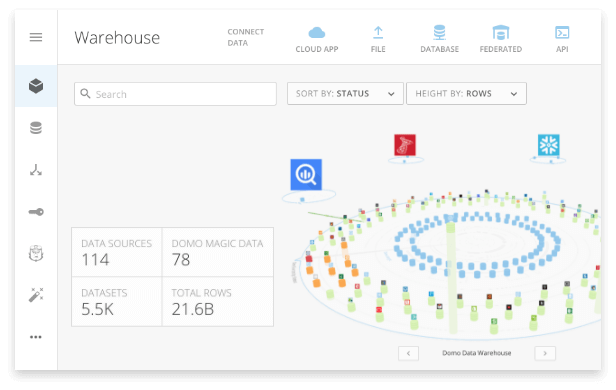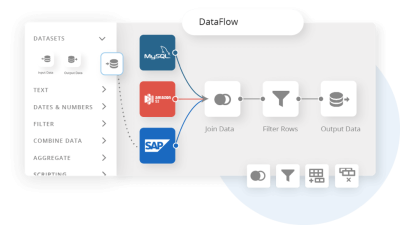The 5 key components of a data pipeline
Storage, preprocessing, analysis, applications, and delivery
Companies and organizations that work with data have to manage the enormous amount of data they collect in order to obtain insights from them.
Big data volume, velocity, and variety can easily overwhelm even the most experienced data scientists. That is why organizations use a data pipeline to transform raw data into high-quality, analyzed information.
A data pipeline has five key components: storage, preprocessing, analysis, applications, and delivery. Understanding the five key components of a data pipeline helps organizations work with big data and use the insights they generate.
In this article, we will break down each component of a data pipeline, explain what each component archives, and the benefits of a powerful data pipeline integration in business intelligence.

Why implement a data pipeline?
A data pipeline helps organizations make sense of their big data and transform it into high-quality information that can be used for analysis and business intelligence.
No matter how small or large, all companies must manage data to stay relevant in today’s competitive market.
Businesses use this information to identify customers’ needs, market products, and drive revenue.
Data pipeline integration is a huge part of the process because it provides five key components that allow companies to manage big data.
The five components of a data pipeline
1. Storage
One of the first components of a data pipeline is storage.
Storage provides the foundation for all other components, as it sets up the pipeline for success. It simply acts as a place to hold big data until the necessary tools are available to perform more in-depth tasks. The main function of storage is to provide cost-effective large-scale storage that scales as the organization’s data grows.
2. Preprocessing
The next component of a data pipeline is preprocessing.
This part of the process prepares big data for analysis and creates a controlled environment for downstream processes.
The goal of preprocessing is to “clean up” data, which means correcting dirty inputs, unraveling messy data structures, and transforming unstructured information into a structured format (like putting all customer names in the same field rather than keeping them in separate fields).
It also includes identifying and tagging relevant subsets of the data for different types of analysis.

3. Analysis
The third component of a data pipeline is analysis, which provides useful insights into the collected information and makes it possible to compare new data with existing big data sets.
It also helps organizations identify relationships between variables in large datasets to eventually create models that represent real-world processes.
4. Applications
The fourth component of a data pipeline is applications, which are specialized tools that provide the necessary functions to transform processed data into valuable information. Software such as business intelligence (BI) can help customers quickly make applications out of their data.
For example, an organization may use statistical software to analyze big data and generate reports for business intelligence purposes.
5. Delivery
The final component of a data pipeline is delivery, which is the final presentation piece used to deliver valuable information to those who need it. For example, a company may use web-based reporting tools, SaaS applications or a BI solution to deliver the content to end-users.
Ideally, companies should choose a data pipeline that integrates all five components and delivers big data as quickly as possible. By using this strategy, companies can more easily make sense of their data and gain actionable insight.

The benefits of a data pipeline integration
The five components of a data pipeline have many benefits, which allow organizations to work with big data and easily generate high-quality insights.
A strong data pipeline integration allows companies to:
- Reduce costs: By using a data pipeline that integrates all five components, businesses can cut costs by reducing the amount of storage needed.
- Speed up processes: A data pipeline that integrates all five components can reduce delivery time to make valuable information much faster.
- Work with big data: Because big data is difficult to manage, it’s important for companies to have a strategy in place to store, process, analyze, and deliver it easily.
- Gain insights: The ability to analyze big data allows companies to gain insights that give them a competitive advantage in the marketplace.
- Include big data in business decisions: Organizational data is critical to making effective decisions that drive companies from one level to the next.
Businesses can work with all their information and create high-quality reports by using a data pipeline integration. This strategy makes it possible for organizations to easily find new opportunities within their existing customer base and increase revenue.

How to implement a data pipeline
By integrating all five components of a data pipeline into their strategy, companies can work with big data and produce high-quality insights that give them a competitive advantage.
The first step to integrating these components is to select the right infrastructure. Businesses can handle big data in real-time by choosing an infrastructure that supports cloud computing.
Next, they need to find a way to deliver information in a secure manner. By using cloud-based reporting tools, companies can ensure the most updated data is being used and all employees have access to updated reports.
Finally, companies should consider how to integrate their existing infrastructure with any new solutions. For example, if an organization currently requires a traditional data warehouse with required integrations, it may be difficult to implement a new cloud-based solution.
When implemented successfully, a data pipeline integration allows companies to take full advantage of big data and produce valuable insights. By using this strategy, organizations can gain a competitive advantage in the marketplace.
Conclusion
The five components of a data pipeline—storage, preprocessing, analysis, applications, and delivery—are important to work with big data.
By choosing an infrastructure that can handle cloud computing and implementing reporting tools for their existing information, businesses can use all the information in their dataset and gain valuable insights into their business.
When combined with other business applications, these components can reduce costs, speed up processes, and help organizations work with big data in a way that gets them ahead of their competitors.
Check out some related resources:

Guide to building robust ETL pipelines

From Data Chaos to Cohesion—Consolidate Your Tech Stack with Domo’s Integration Capabilities






